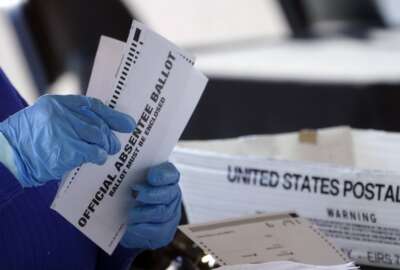Federal appeals court upholds USPS regulator’s decision to allow higher mail rates
A three-judge panel with the U.S. Court of Appeals for the D.C. Circuit found the Postal Regulatory Commission struck a careful balance last year when it allowed...
A federal appeals court is upholding a Postal Service regulator’s decision that has led to higher mail prices.
A three-judge panel with the U.S. Court of Appeals for the D.C. Circuit found the Postal Regulatory Commission (PRC) struck a careful balance last year when it allowed USPS to set mail rates higher than the pace of inflation.
The judges, in their Nov. 12 ruling, agreed the commission’s new rate-making system included “sufficient safeguards” to prevent excessive rate increases, and gave USPS customers an outlet to challenge rate changes before the commission.
Several major associations of mailers led the lawsuit, arguing the commission went too far in giving USPS the ability to set rates above inflation.
“Despite the mailers’ objections to the new ratemaking system, the commission articulated a rational connection between the statutory objectives and the decision it made,” the judges wrote.
New USPS prices allowed under this new rate-setting system went into effect in August. The price of most mail products rose by 6.8%, including the price of a first-class stamp, which went up from 55 cents to 58 cents. Magazines, newspapers and catalogs saw an 8.8% price increase.
USPS spokesman David Partenheimer said the court’s decision demonstrates the commission “has the clear statutory authority to adopt a regulatory system for mailing services that achieves the statutory objectives, including the objective that the Postal Service be financially stable.”
“The prior system that capped price increases for mailing services at the Consumer Price Index failed to give the Postal Service the ability to respond to changing market realities, and contributed to years of financial losses and underinvestment in our network,” Partenheimer said.
USPS under its 10-year reform plan, he added, is looking to “optimize revenues through judicious use of the pricing authorities that have been upheld by the court.”
USPS earlier this month reported a continued decrease in first-class mail volume, its most profitable product. The agency saw a 3.67% decline in first-class mail volume from fiscal years 2020 to 2021, but increased operating revenue by 5.3%, mostly through a continued surge in its package business under the COVID-19 pandemic.
Mike Plunkett, the president and CEO of the Association for Postal Commerce, one of the plaintiffs in the lawsuit, said the court upheld the PRC’s final rulemaking on a new rate system, “but it doesn’t really alter the basic facts on the ground, which is that the Postal Service operates a government monopoly.”
“The customers of the Postal Service need protection from monopoly pricing, and the Postal Service needs to focus on being more efficient. And we believe the PRC is crucial to making sure those things happen,” Plunkett said.
The legal battle stemmed from the commission’s mandate under the 2006 Postal Accountability and Enhancement Act to conduct a 10-year review of the formula used to set USPS mail rates.
As part of that review, the PRC had to ensure its rate-setting system met nine statutory objectives meant to ensure the long-term sustainability of USPS.
After finding that the old USPS rate-setting system “did not meet the objectives relating to the financial health of the Postal Service,” the commission introduced a new rate-setting system last year that would keep a price cap on market-dominant products like first-class mail, but would allow USPS to set prices above the rate of inflation based on changes in mail density and its workforce retirement costs.
Plunkett said allowing USPS to set higher rates based in part on a decline in mail density “rewards the Postal Service when volume declines.”
“I don’t think we’re in a death spiral for first-class mail yet, but it certainly sets the table for that to happen, if the Postal Service and their Board of Governors do not act prudently. And so far, they appear to be intent on maximizing every single ounce of pricing leverage they have,” Plunkett said.
Lawyers for the plaintiffs argued the commission didn’t give equal consideration to some factors, such as maximizing USPS incentives to cut costs, increase efficiency and meet service targets.
The judges, however, agreed with the commission’s determination that the old rate system didn’t maintain the financial stability of USPS, and that the new system it implemented balanced all of its statutory considerations.
“Given the deference due to an agency’s judgment about how to balance competing factors, mailers offer no basis for the court to conclude that the commission’s decision was arbitrary and capricious in meeting the statutory objectives,” they wrote.
The court dismissed mailers’ concerns that higher prices for first-class mail under this new rate system would trigger a “death spiral” of declining mail volume.
The judges backed up the commission’s claim these concerns “rested on the faulty premise that market-dominant products are highly price sensitive.”
Steve Kearney, executive director of the Alliance of Nonprofit Mailers, another plaintiff in the lawsuit, said nonprofit groups and the people they serve “will be harmed by the new PRC rules and the way USPS is using them.”
“A fatal flaw in the PRC’s approach was not taking the massive changes brought on by the pandemic, including the very profitable increase in USPS package revenue,” Kearney said.
The court denied a request from the mailers associations in August to block USPS from raising rates on first-class mail and periodicals until its ongoing lawsuit was settled.
The judges also cast doubts on the plaintiffs’ claims during oral arguments in September, saying the plaintiffs would have to prove that the commission didn’t just misapply one factor, but that its balancing of all nine statutory factors together was “arbitrary and capricious.”
The PRC’s new rate-setting system, however, remains a compromise. USPS attorneys argued the commission didn’t go far enough to give the agency flexibility to adjust prices and regain long-term financial stability, and sought to completely reset prices on its monopoly of mail products.
USPS told the court the commission’s new rate-making system added some pricing flexibility, but not enough to cover its costs, and warned the new system “perpetuates the same faults that [the commission] found in the legacy system.”
“Analogizing its situation to that of a bicycle tire with a leak, the Postal Service argues that the commission’s new system had not only to account for future revenue loss (i.e., patch the hole) but also return rates to a compensatory level (i.e., reinflate the tire),” the judges wrote in their ruling.
While USPS argued its long-term financial problems remain a concern, judges found the commission “reasonably concluded that although a rate reset might further the goal of financial stability, it would undermine other objectives.”
Copyright © 2025 Federal News Network. All rights reserved. This website is not intended for users located within the European Economic Area.
Jory Heckman is a reporter at Federal News Network covering U.S. Postal Service, IRS, big data and technology issues.
Follow @jheckmanWFED






